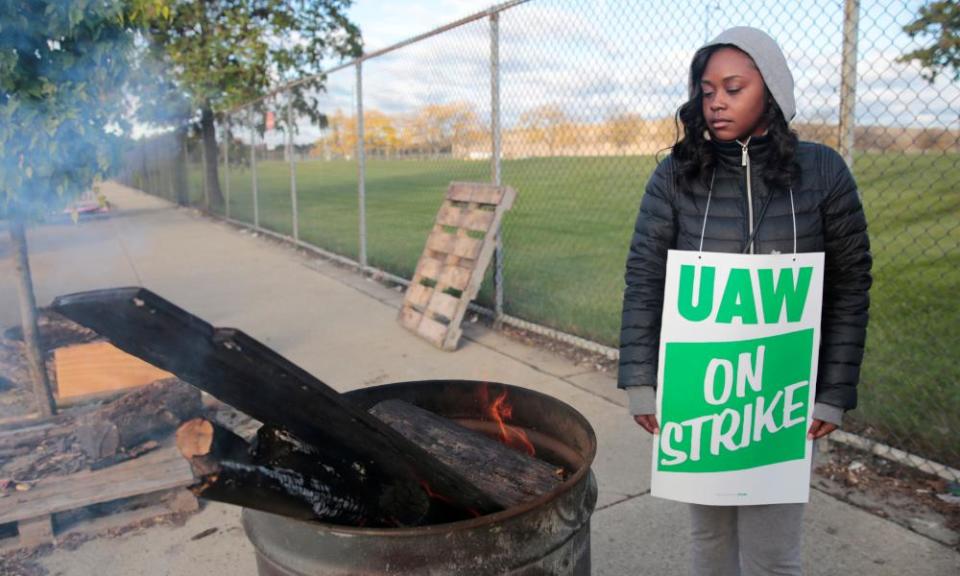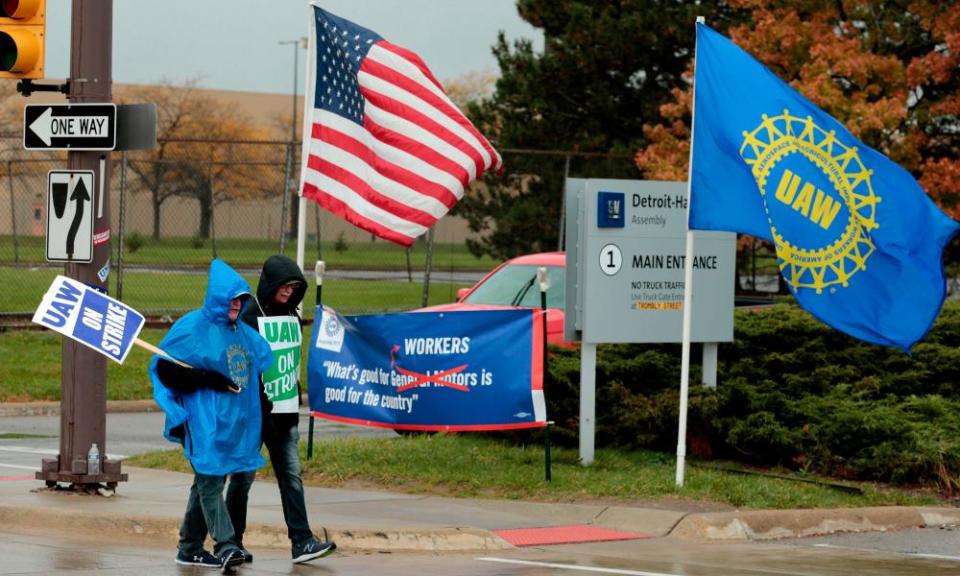GM workers anxiously await resolution to longest strike in decade

The autoworkers picketing outside General Motors’ Detroit-Hamtramck assembly plant stand to gain more than most if a tentative deal with the company is ultimately approved this week. For a start their jobs would be spared. GM previously slated the plant for closure by January. Instead, its 700 employees could start building electric pickup trucks next year.
But as the United Auto Workers (UAW) strike appears to be ending, after more than a month, emotions outside the plant were decidedly mixed last week. Those who spoke with the Guardian said their feelings fell somewhere between “cautiously optimistic” and “skeptical” as a slow trickle of news came from UAW leadership.
The union released an outline of the deal last week but the details are still only known to “the guys at the bargaining table”, said Paul Radatz, a 34-year company veteran. Over the weekend UAW members were getting to grips with those details. Voting started on Saturday and is expected to be completed by Friday.
“What we hear so far all sounds good, but that’s what they’ll do – come out and tell us all the highlights,” he said. “But this happens with every contract, and there are always things that we have lost that don’t come out until it’s ratified and in print. So we’re waiting for the other shoe to drop.”
An hour north in Flint, D’Andre Jackson, a UAW district committee representative said workers at the Flint assembly plant shared that sentiment. While there’s some optimism, “there’s some anxiety” over what isn’t yet known.
“I don’t want to see just the shiny chrome pieces. I want to see the meat and potatoes,” Jackson said.
The strike has cost GM $100m a day, according to analysts, and there’s no doubt that the UAW has won some significant concessions, a major victory for the union after its longest strike in 10 years. Workers are also feeling ebullient about the resurgence of unions, which are gaining ground as teachers and others have successfully campaigned for wage rises and more. But striking takes its toll.
On a cold and windy Thursday small groups of employees waved signs outside the six entrances around the sprawling, 4m sq ft Detroit-Hamtramck plant just a few miles north of GM’s downtown headquarters. They warmed themselves around fires burning in 55-gallon drums and pumped fists as passing motorists hit their horns in solidarity.
The highlights of the deal that UAW workers are processing include $11,000 ratification bonuses, paths to full-time employment for temporary workers, pay increases, no changes to healthcare, and other clear wins for the union. The UAW national General Motors council decided on Thursday to recommend ratification, and the rank and file will now vote on it.
At least one obvious sticking point remains. Some outside Detroit-Hamtramck vowed to vote against any deal that didn’t also include new product for the recently shuttered Lordstown, Ohio, plant.

Beyond that, some frustration still exists, and Radatz said management’s “greed” is still on his mind. He noted that the $11,000 bonuses pale in comparison to the roughly $11,000 per hour that GM’s CEO, Mary Berra, earns. He and others say they aren’t convinced that GM ever truly planned to close Detroit-Hamtramck Assembly because the company invested big in it in recent years, while rumors of an electric truck started months ago. Radatz called the proposal to close the plant a false “negotiating chip”.
“Now they can say, ‘See, we’re bargaining in good faith,’ but they haven’t been. That’s a joke,” Radatz said. “But I can’t blame them. You want to have an ace up your sleeve.”
Feelings outside Detroit-Hamtramck were also mixed over building electric trucks. While the plant may live to see another day, some are disappointed the company is only promising “a low volume” vehicle that’s viewed as a “test product to see how the public takes to it”. But Julaynne Trusel, a team leader in the body shop, said it beats the alternative.
“The doors are staying open and everyone doesn’t need to start looking for jobs, so at least it’s a step in the right direction,” she said. “Hopefully we get some more business over the life of the contract.”
Though there’s still some frustration over the bitter fight that played out in recent years and culminated with the strike, employees don’t expect any resentment to linger should the stoppage conclude. After all, the two sides were just “looking out for themselves”, Trusel said.
“This is just business and everyone had to handle their business,” she said. “When we come back together, we are going to be like one. We all want to produce the best cars that we can for our customers, so we’re not going back in with a bad attitude.”
George Raptis, a materials department employee who has been at Detroit-Hamtramck since 1993, echoed that: “We all want to get back to work, and when we do things will go on like it’s another day.”
The stoppage, which is the longest GM has faced since 1970, is inflicting pain on both sides. About 48,000 UAW workers, including 17,000 in Michigan, walked off the job. GM has lost more than $1.5bn because of the strike, while union workers lost more than $835m in wages, according to the East Lansing industry analyst Anderson Economic Group. Union workers are earning just $250 a week, and GM temporarily pulled their health insurance last month.
“$250 per week is less than my spousal payment, so I’m in the hole,” said a Detroit-Hamtramck body shop employee and 35-year company veteran who declined to give his name. In Flint, Jackson delayed renovations on a new house he and his wife purchased not long before the strike.
“You definitely tighten up the belt and fry up a couple bologna sandwiches instead of grilling up some steaks,” he said.
Trusel added that support from other unions and the public helped get workers through financial difficulties. Those picketing outside the plant received free meals and donations of food, diapers, toiletries and other essentials.
“There’s been so much support for us. It brings you to tears to know that people care so much,” Trusel said. “It’s been encouraging to know that so many people are saying ‘Stand your ground’.”
Should the union come away with a win and public support for workers remain high, the strike could be a shot in the arm for the UAW and the largely beleaguered US labor movement. Radatz applauded leadership for “locking horns with GM” and said its handling of the strike so far has restored the rank and file’s faith.
“The union was very weak before the contract and now it’s solid,” he said. “People are standing with each other and they’re backing each other 110%.”
